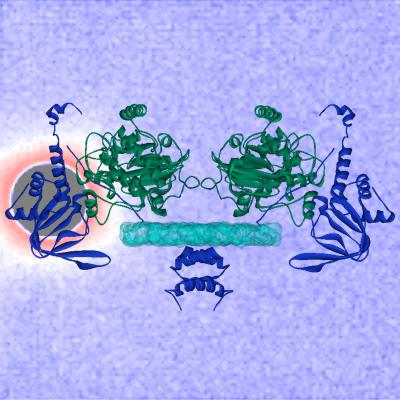Advanced X-ray, neutron beam imaging reveal workings of powerful biochemical switch PKA

With a background of scattered neutrons, this image shows a model of the II-beta form of PKA. A neutron beam used for imaging (behind gray circle) helped researchers identify a region of II-beta that is likely to give PKA its unique shape. Credit: William Heller, Oak Ridge National Laboratory
Learning more about how the Protein Kinase A (PKA) switch works will help researchers to understand cellular function and disease, according to Donald K. Blumenthal, Ph.D., associate professor of pharmacology and toxicology at the University of Utah (U of U) College of Pharmacy who led the study. “To develop new drugs and treatments for disease, it's important to understand how PKA works,” he says. “This study helps us get a clearer picture of how the PKA protein helps regulate cellular function and disease.”
The study, published in the Oct. 10 issue of the Journal of Biological Chemistry as its paper of the week, is a collaboration among researchers at the U of U, University of California, San Diego (UCSD), and Oak Ridge National Laboratory in Tennessee.
The PKA protein comes in four forms, each of which serves as a sensor for a signaling molecule called cyclic AMP (cAMP). When these forms of PKA sense cAMP, they change shape, which researchers believe is critical in determining how PKA works as a biochemical switch.
Many hormones, neurotransmitters and drugs communicate with cells by changing the level of cAMP found within them. Accordingly, PKA helps regulate cellular activity in reaction to different levels of cAMP within cells. Because PKA serves as a master switch in cells, mutations in it lead to a variety of diseases including metabolic disorder, disorders of the brain and nervous system, cancer and cardiovascular ills.
Blumenthal and colleagues focused on a form of PKA called II-beta, a protein found mostly in the brain and fat cells that is suspected of being involved in obesity and diet-induced insulin-resistance associated with type 2 diabetes. II-beta contains two mechanisms for sensing cAMP, each of which unfolds and separates in response to the signaling molecule.
The researchers wanted to know whether both of II-beta's cAMP-sensing mechanisms are required to determine its ability to change shape – a critical factor for its function. To answer this, they removed one of the cAMP sensors and used advanced small-angle neutron scattering imaging, a technology available at Oak Ridge's High Flux Isotope Reactor, and small-angle X-ray scattering at the U of U, each of which produces images that reveal information about the shape and size of molecules. The images showed that II-beta does, indeed, change shape with only one sensor.
“By process of elimination, this must mean that parts of the remaining single sensor of II-beta give it its unique shape and internal architecture,” says Susan Taylor, Ph.D., professor of chemistry, biochemistry and pharmacology at UCSD and co-author on the study. “Our findings further narrow and define the key components of II-beta and identify new regions for further study.”
Future research should focus on a part of II-beta called the “linker region,” which connects the remaining cAMP sensor with a part of II-beta that helps target PKA to specific cell locations, according to Blumenthal. “Based on what we know about II-beta and other forms of PKA, it's likely that the linker region plays a major role in organizing the internal architecture and shape changes the determine the unique biological functions of PKA.”
###
The study's co-authors include Jeffrey Copps, Eric V. Smith-Nguyen and Ping Zhang, UCSD Department of Chemistry and Biochemistry and Howard Hughes Medical Institute and William T. Heller, Oak Ridge National Laboratory.
Funding support for this research came, in part, from the U.S. Department of Energy and the National Institutes of Health (grant GM34921).
Media Contact
More Information:
http://healthcare.utah.edu/publicaffairs/All latest news from the category: Life Sciences and Chemistry
Articles and reports from the Life Sciences and chemistry area deal with applied and basic research into modern biology, chemistry and human medicine.
Valuable information can be found on a range of life sciences fields including bacteriology, biochemistry, bionics, bioinformatics, biophysics, biotechnology, genetics, geobotany, human biology, marine biology, microbiology, molecular biology, cellular biology, zoology, bioinorganic chemistry, microchemistry and environmental chemistry.
Newest articles

Sea slugs inspire highly stretchable biomedical sensor
USC Viterbi School of Engineering researcher Hangbo Zhao presents findings on highly stretchable and customizable microneedles for application in fields including neuroscience, tissue engineering, and wearable bioelectronics. The revolution in…

Twisting and binding matter waves with photons in a cavity
Precisely measuring the energy states of individual atoms has been a historical challenge for physicists due to atomic recoil. When an atom interacts with a photon, the atom “recoils” in…

Nanotubes, nanoparticles, and antibodies detect tiny amounts of fentanyl
New sensor is six orders of magnitude more sensitive than the next best thing. A research team at Pitt led by Alexander Star, a chemistry professor in the Kenneth P. Dietrich…





















